Contents
Most varieties and hybrids of apple trees are hardy and cold-resistant. However, sometimes trees just don’t “wake up” after the winter. This can be caused by various reasons, so it is important to understand why apple trees do not bloom, focusing on their condition. In most cases, such a problem does not mean the death of the tree, it is quite possible to “wake it up”.
When the leaves of the apple tree begin to bloom
It is impossible to specify a specific time when the leaves of the apple trees begin to bloom. It all depends on the characteristics of the variety and hybrid, the weather in winter and spring, the quality of tree care and other factors. In central Our Country, buds bloom around the 20th of May. But if the spring is early and warm, it can happen 10-15 days earlier. In regions with a more severe climate, most often you have to wait until the end of May or even the first decade of June.
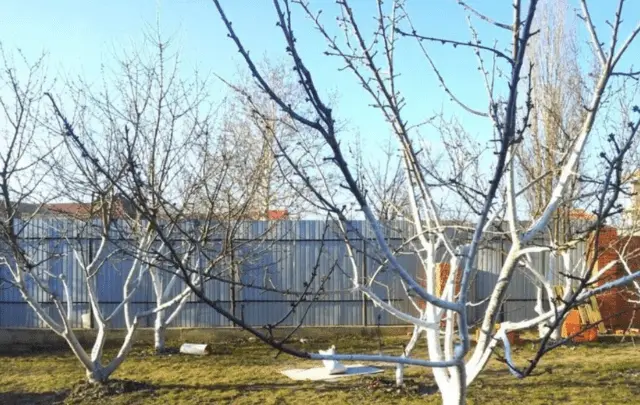
Apple trees don’t bud at the same time each season, and that’s perfectly normal.
Why the leaves on the apple tree do not bloom well after winter
If the apple tree does not open buds after winter, it is necessary to carefully examine the tree. Despite the declared cold resistance of a variety or hybrid, severe frosts, combined with other negative factors, can cause serious harm to it. This is clearly evidenced by the leaves that have not blossomed in spring.
Damage to wood by freezing temperatures
When the winter is harsh (the temperature is below -30 ° C for a long time), windy and with little snow, the “frostbite” of wood is almost inevitable. Similarly, they are affected even by not too frequent (4-5 times enough) change of thaws to frosts during the winter.
The severity of damage is determined by the color of the wood. If it is yellowish-beige, the problem can be considered minor, severe frostbite is indicated by a rusty brown tint. When the leaves of an apple tree do not bloom in spring, and its wood turns brown or blackens, it is much more difficult to help the tree, but it is also possible.
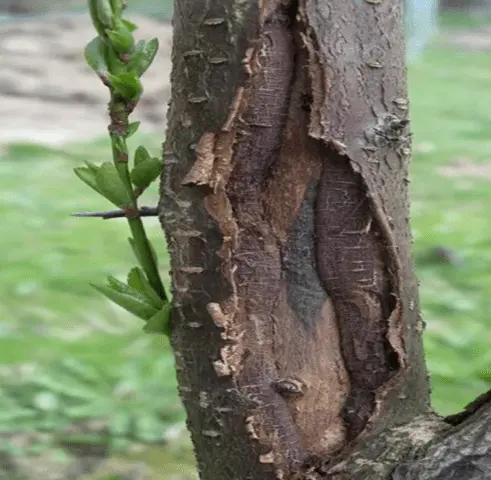
Frost-damaged wood becomes very brittle, the apple tree breaks under its own weight
Mechanical damage to the bark
The most vulnerable point is the junction of the branches and the trunk. After a harsh winter, the bark becomes very thin, in the spring, when the air temperature rises and the sun becomes more “active”, the apple tree gets burned. Their appearance is evidenced by the red-brown shade of the bark.
When the area of burns is significant, the bark dies off. The tree is very weak, so the leaves and flower buds do not bloom on it – the apple tree simply does not have enough strength, they are sent to “treat” the resulting damage.
broken branches
Frequent drops in negative and positive temperatures during the winter are dangerous not only for “frostbite” of wood. As a result, the branches break or crack under the weight of the ice freezing on them. The sap flow system is disturbed, some of the leaves and flowers on the affected shoots do not bloom.
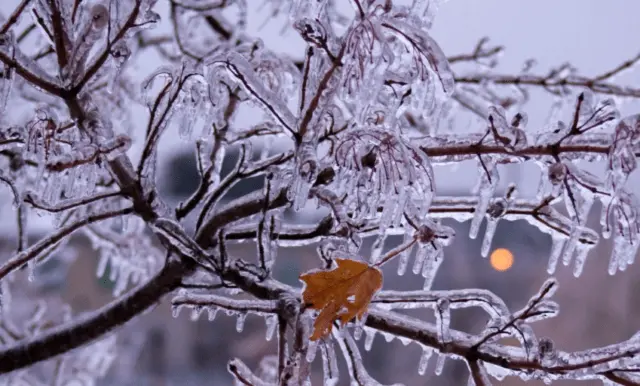
It looks very nice and unusual, but this is a serious load on the tree.
Affected kidneys
If the gardener neglects the care of the apple tree, in particular, its preparation for winter, leaf and flower shoots are the first to suffer. The experience of gardeners shows that the buds on the tops of the shoots mostly “survive”. Others quickly die and fall off.
It is also possible damage to leaf and flower buds by return spring frosts. In regions with a harsh climate (the Urals, Siberia, the Far East), negative temperatures in May and even in June are not excluded at all.

For most varieties and hybrids of apple trees, even a short exposure to cold is detrimental.
“Gnawed” roots or trunk of an apple tree
The apple tree needs to be protected for the winter not only from frost, but also from rodents. Otherwise, mice, rats, hares will consider its wood a delicacy. Such “nibbling” poses a serious danger to the vascular system. Leaves and flower buds on such trees may not bloom for several seasons until it recovers.

Rodents are a danger to any fruit trees
Application of nitrogen fertilizers in the fall
Nitrogen is a macronutrient that an apple tree needs in spring, at the stage of active formation of green mass. Then it is even harmful for her – the tree begins to “fatten” to the detriment of fruiting. Nitrogen top dressing is especially dangerous in the fall – this macronutrient activates the growth processes of a tree, preventing it from “hibernating”. As a result, the leaves begin to bloom in autumn and inevitably die in winter from frost.
What to do if the apple tree does not bloom in the spring after winter
A “withering” apple tree, in which leaves and flowers do not bloom, can in many cases be saved. The main thing is to take the necessary measures already in the current season and be patient, giving the tree time to fully recover.
When freezing
If the leaves do not bloom on the apple tree due to the “frostbite” of the wood, it needs competent pruning. But depending on the degree of damage, you should act differently:
- When black-brown wood indicates “frostbite” of critical severity, hasty decisions and actions will only harm the apple tree. It is necessary to wait until the tree, on which the leaves have not blossomed, nevertheless “wakes up”. The so-called tops, emerging from the “sleeping” kidneys, will become a new “skeleton”.
- If the wood of the apple tree is brown, on the contrary, it is impossible to hesitate with pruning. All affected shoots are removed even before the leaves should bloom on the tree. Then the apple tree, so that it does not die, is provided with “donors” of water and nutrients. In the trunk circle, close enough to it, 2-3-year-old “wild birds” are planted. Usually 4-5 pieces are enough. Planting pits for them are prepared, as for “cultivated” seedlings, and the tops of the trunks are grafted under the bark of an apple tree with damaged wood, which does not bloom in spring. During the season, the resulting “symbiosis” is not fed with mineral fertilizers, limited to abundant watering. If buds form on the “main” tree, they are immediately cut off, preventing them from blooming.
- An apple tree with slightly yellowed wood is the easiest to “wake up” after winter. As a rule, it is enough to spray it with cold water in the morning, and after a few days, treat it with any biostimulant.
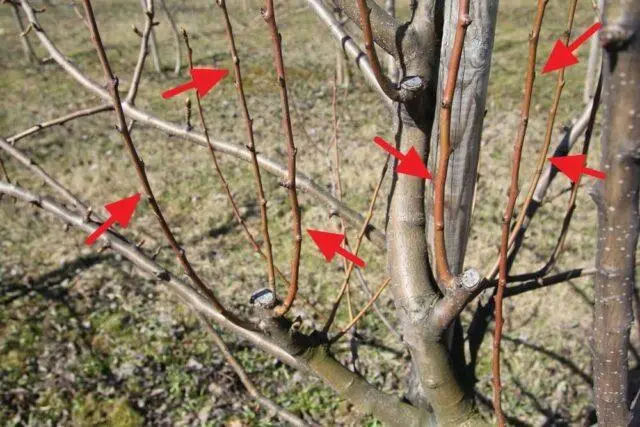
“Useless” and even “harmful” spinning tops when the apple tree freezes help restore its “skeleton”
When attacked by rodents
As soon as the positive temperature is established, all the “wounds” left by rodents on the apple tree, in which the leaves have not blossomed, are disinfected by washing with a solution of any fungicide, cleaned and covered with garden pitch. Otherwise, the situation will be further complicated by infection. This treatment, coupled with competent care and several sprayings with biostimulants during the season, is quite enough for a tree with superficial mechanical damage (bark and cambium) to regain strength over the summer. The next season the leaves will bloom as usual.
If the stem of an apple tree has been gnawed over half the thickness during the winter, the only way out is to provide it with “donors”, just like a tree with heavily frozen wood. Instead of “wild” seedlings, you can use the root shoots of the apple tree itself.

Installing protection against rodents is a necessary step in preparing an apple tree for winter
At faults
Any breaks found on an apple tree that does not bloom leaves must be disinfected by washing with a fungicide or a “home” remedy with an antiseptic effect. Next, proceed as follows:
- Thick “double” trunks above the fracture point are tightly tied with wire, placing a soft cloth under it so that it does not cut into the wood and injure it even more. Then a hole is drilled 5-10 cm below, a bolt is inserted into it and a nut is screwed on.
- Thin trunks or large fruit-bearing branches with a diameter of 4-5 cm are similarly fixed with a wire tie. Then two building brackets “looking” in different directions are driven crosswise into the wood.
- Small branches of an apple tree, on which leaves do not bloom due to breaks, are fixed with screws, leaving their ends sticking out.

All items used to tighten faults are also disinfected.
In case of damage to the kidneys by pests
Apple flower beetle or weevil is a pest that activates in the spring when the air warms up to 10 ° C. Its larvae eat away leaf and flower buds from the inside, leaving only superficial scales.

To notice the attack of the pest at an early stage, apple trees are regularly inspected, looking for drops of “liquid” on the kidneys.
Having found a characteristic symptom, apply suitable insecticides (Decis, Biotlin, Fufanon, Kinmiks), following the instructions in the instructions. In autumn, preparations for winter are especially carefully carried out, including cleaning the near-stem circle from plant debris, deep loosening of the soil, and whitewashing the bole.
How to process
If it was not possible to understand why the apple tree does not wake up after the winter, it is recommended to use biostimulants. The concentration of the solution, the method and frequency of treatments are determined based on the instructions given by the manufacturer.
Stimpo
At the same time, a biostimulant and a drug that positively affects the immunity of the apple tree. It can be used on non-leafing trees with most phytosanitary treatments, including mixtures. A balanced complex of phytohormones and trace elements is responsible for a positive result.

Stimpo can be sprayed on apple trees and other horticultural crops at all stages of vegetation
Pennant
The drug is of natural and synthetic origin. It is used mainly to increase the “stress resistance” of plants. With regular use, it can completely replace fungicides. For maximum effect, the treatment is carried out three times – while the leaves of the apple trees have not yet blossomed, at the time of bud formation and immediately after flowering.
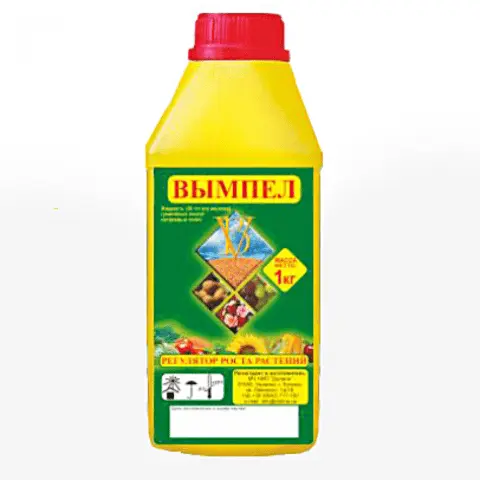
Pennant not only helps apple trees “wake up” after winter, but also increases their yield by about a third
Albite
A complex product that combines the properties of a fungicide, a biostimulant and a growth regulator. The drug is completely natural, obtained from bacteria and other microorganisms living in the soil. It is recommended to spray apple trees if they do not have leaves for “awakening” and in the rosebud phase to increase “stress resistance” and yield.

Albit removes the phytotoxic load from apple trees that do not bloom leaves
Conclusion
If apple trees do not bloom after winter, something is clearly wrong with the trees. Therefore, the gardener must definitely find the cause of the protracted “hibernation”. As a rule, there are no problems with this – accompanying symptoms help. “Waking up” a tree is quite real, the main thing is to take effective measures in time. Then the damage to the apple tree can be minimized, this will not affect its development and fruiting.









